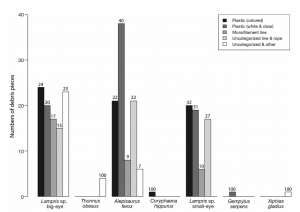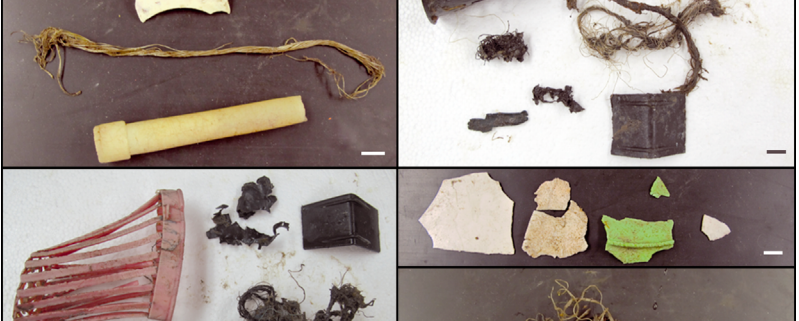Plastic ingestion in fish
By Dani Escontrela, RJD Intern
Plastic debris is becoming a very prevalent problem for our world’s oceans. In fact two of the ocean’s largest features, the North Pacific and North Atlantic Subtropical gyres, have large patches of anthropogenic debris floating in its waters. There has been a significant amount of research that has found plastic or other anthropogenic debris in the stomachs of sea birds, invertebrates, marine mammals and planktivorous fishes. This debris can be harmful to these species as it can lead to physical entanglement, decreased nutrition from intestinal blockage, suffocation and decreased mobility; plastic can also be a vector for other harmful contaminants. As much research as there is about anthropogenic debris ingestion by the species mentioned, there aren’t many studies about ingestion by large marine fishes. This study set out to study this phenomenon by sampling large, pelagic predatory fishes from the central North Pacific subtropical gyre surrounding the Hawaiian Island archipelago.
Observers from NOAA’s Hawaii Observer Program where placed on commercial long lining vessels were they collected the stomachs of large pelagic fish species from deep and shallow waters. Stomach contents were analyzed back at the lab. Everything in the stomachs was weighed, both prey and anthropogenic debris, and the analysis was even able to weigh the microplastics (<5mm). The fish studied were all foraging species which tended to move across different depth strata. In addition, the buoyancy of the plastics collected was determined to figure out where in the water column the debris was consumed.
All in all, samples were taken from ten species belonging to six different families (sample size was 595 individuals). It was found that in total 19% of the fishes examined had debris although three species seemed to contain no debris at all. Most of the anthropogenic debris consisted of plastic and different types of fishing nautical lines and rope pieces. It was also found that the debris that was tested for buoyancy floated in all four types of sea water which represented the water found at different depths.

Examples of different types of anthropogenic debris found the in the stomachs of different fish species
There have been previous studies done about debris ingestion by higher tropic level fishes but none had such a large sample size. In this study, they found, as compared to other research done, that the ingestion of anthropogenic debris by higher trophic level pelagic fishes is not uncommon and in fact it may be more prevalent in certain species than previously observed.

Number of each type of marine debris categorized per species (bars indicate relative proportions within each species)
This leads to the question: why do mesopelagic species have debris in them that originated from surface waters? One plausible answer is that since our understanding of these fish’s movements is incomplete, they may actually go to the surface and consume the plastic there. Another answer is that the debris is there because their prey previously consumed it. However, this theory can be dismissed because the size of the plastics the prey consumed was smaller than the plastic observed in the stomachs of the fish in this study. A third explanation might be that the plastic was ingested as the fish were hauled to the surface; however the proportion of plastic found in the different species would be approximately equal. A more possible reason is that the plastic was actually consumed by the fishes at depth. Although the study found the debris to be positively buoyant, it might not have been positively buoyant before consumption. In fact it is likely that consumption by the fish changed the characteristics of the debris. The last explanation is that wind-driven mixing, downwelling and/or currents caused the debris to be pushed into deeper layers of the water column.
The question remains: why do they consume this debris? Most likely because it looks like their prey. These findings highlight two new perspectives about the global plastic debris issue. First of all, the concern that these commonly consumed pelagic fish have so much debris in them. Second of all, that through circulation patterns and the connectivity of epi- and mesopelagic food webs we are finding anthropogenic debris in the deeper layers of the ocean. There isn’t much research on what the ingestion of plastic does to the health of the fish, but it is likely that there are elevated levels of toxins absorbed by the fish. Future research should focus on whether the elevated levels of toxin that might be found in the fish may pose a risk to the seafood-consuming public.
REFERENCE
Plastic for dinner? Observations of frequent debris ingestion by pelgaic predatory fishes from the Central Pacific. Choy, C, and Drazen, J. (2013) Marine Ecology Progress Series.




Leave a Reply
Want to join the discussion?Feel free to contribute!